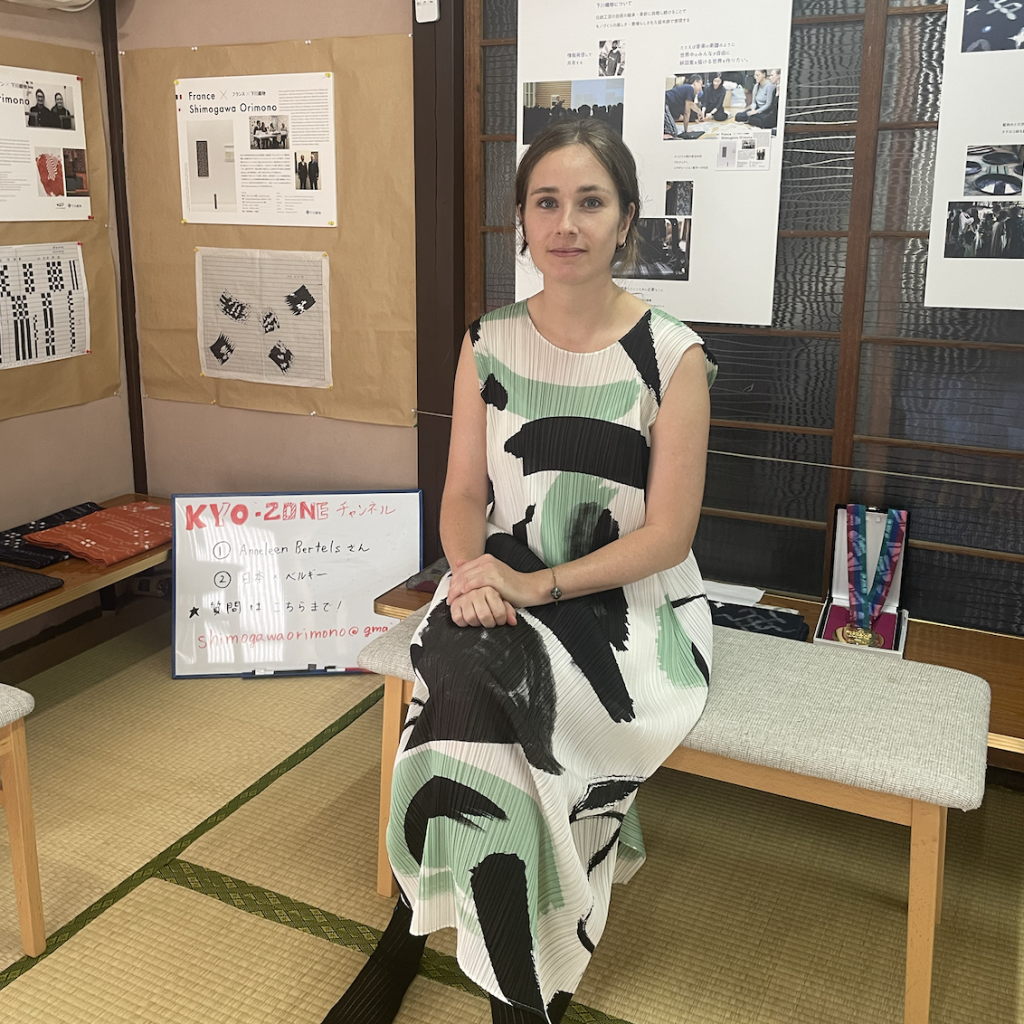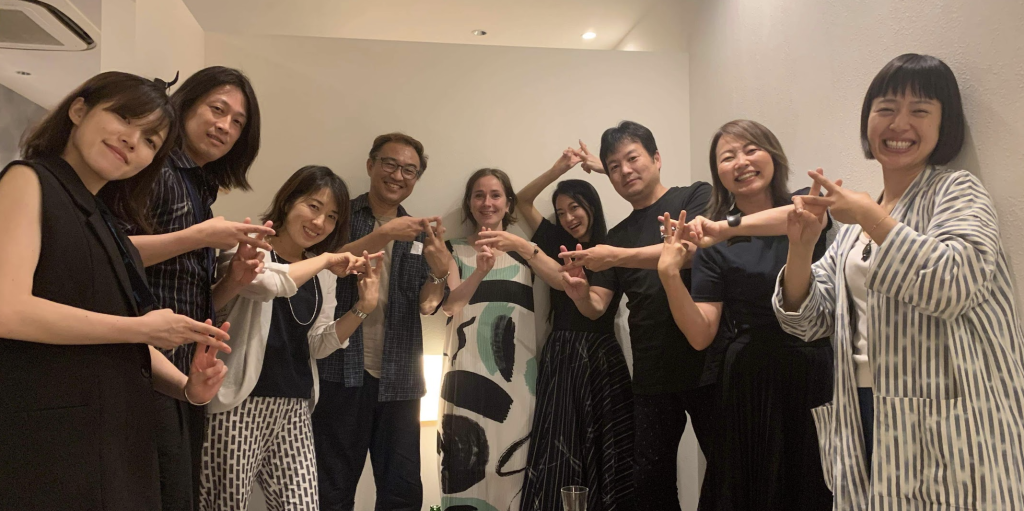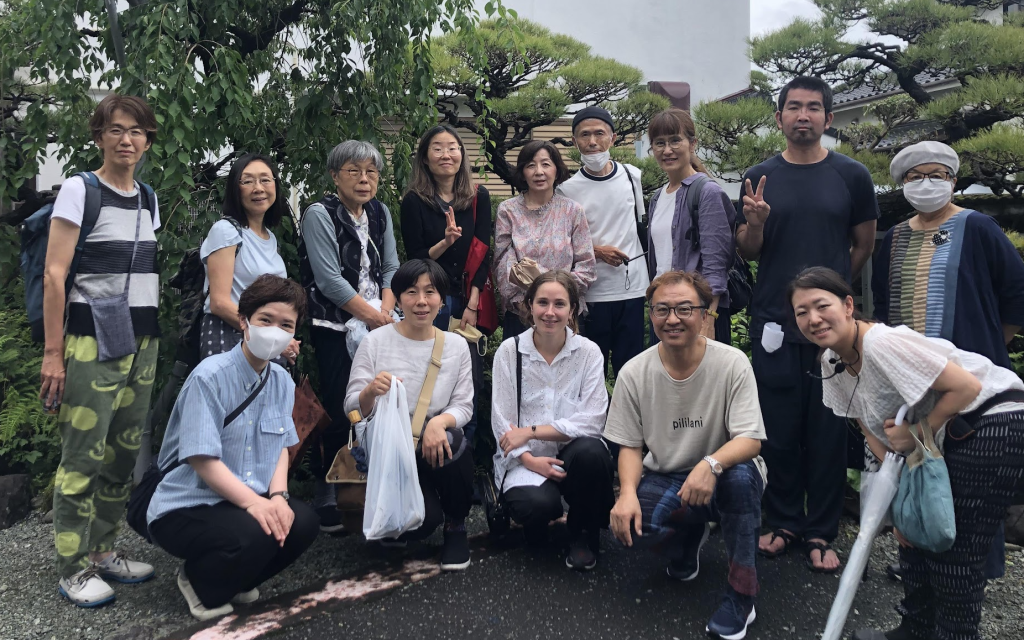久留米絣という名の未来を共有するインタビュー
2023年7月21日
*英語コメントの後に、日本語訳を記載しています(Google翻訳)
Interview Shimogawa-san
- Self introduction:
Lab:
My name is Anneleen Bertels and I am a textile creator based in Brussels. In my Textile + Embroidery Lab I research how new (sustainable) materials and innovative technologies interact with traditional crafts.
For example, I investigate how natural products such as algae can result in new fibres, how I could collaborate with almost-forgotten weavers, or how I can combine the intimacy of handcraft with the efficiency of machinery.
The Lab collaborates with other craftsmen to exchange ideas and to experiment with various jewellery, embroidery and textile techniques.
Through an ongoing collaboration with a goldsmith, the Lab researches how jewellery and textile design can be ‘melted’ or embroidered together into a new material or technique.
My main focus is to create a contemporary vision on embroidery by zooming in to the design and innovation of all elements of embroidery applications – yarns, beads and techniques.
The Laboratory is open to freelance projects for different fashion houses and institutions, interdisciplinary collaborations, as well as self-initiated design and art projects.
Background:
In 2013 I graduated at Artez Institute of The Arts (Arnhem, The Netherlands) in Fashion Design.
I gained diverse experiences as a fashion designer and product developer for several major fashion houses such as Balenciaga, Maison Martin Margiela and Ann Demeulemeester. Through various artisanal collaborations, I gave myself the freedom to explore other disciplines and crafts such as goldsmithing.
I have always had an inborn and unexplicable passion for textiles and the microscopic universe of pearls. In 2022 I choose to fully dedicate myself to my passion for the craftsmanship of textiles and found my own Textile & Embroidery Lab. In my tactile “handwriting”, textile, embroidery and jewellery design flow together.
The depth and innovation that I was missing when I worked in the fashion industry now feels very much present in my work as a textile creator.
On one hand I keep perfecting my artisanal haute couture embroidery techniques, on the other I experiment with traditional and innovative production methods to create my own beads from reclaimed materials. I love to collaborate with craftsmen to feed my knowledge and curiosity for other crafts.
Since September 2022 I am part of the incubator program for 2 years at MAD Home of Creators in Brussels. It provides me coaching and a platform for the creative and business development of my Textile & Embroidery Lab.
Mission of my work:
With my work I create a contemporary vision on what embroidery can and could be, now and in the future. I want to interweave textile cultures and achieve innovative craftsmanship. I want to manifest a physical form of poetry.
I want to create awareness on how things are made and our relationship to the objects we wear and use everyday.

- Purpose of coming to Japan:
My fascination for Japanese craftsmanship, ingenuity, poetry and vision of beauty began years ago with reading the books “The Beauty of Everyday Things” and “The Unknown Craftsman – A Japanese Insight into Beauty”, both by Soetsu Yanagi. He was a Japanese art critic, philosopher and founder of the Mingei (folk art movement) in Japan in the late 1920s and 1930s. I have always had an inexplicable passion for Japan’s textile paradise, and as a result, I began to study Japanese heritage and textile crafts.
Thanks to a grant from Flanders State of the Art, I got the opportunity to make my dream come true and execute my research trip in Japan from May to July 2023 to do research on traditional Japanese textile crafts and fibres. I mainly wanted to do research on the techniques Hikihaku, Bashofu and Kasuri. But many other crafts came along the way.
During my trip in Japan my mission was to research how the rich Japanese cultural history in crafts is interwoven into today’s vision on craftsmanship and innovation. I wanted to connect with local textile artisans, get involved in their making process and see how we can experiment together and discover how to create a shared contemporary vision on traditional textiles.
Kyoto-Kyotango: Diving into the (cultural) history of Japan and connecting to craftsmen:
During May-June I was connected to a residency called “Bridge to Kyoto” in Kyoto. During that period I also went to Okinawa to do research in the craft of Bashofu.
‘Bridge To Kyoto’ is a residency for transdisciplinary & transnational activities with the aim to connecting to local artisans and exchanging ideas with an (inter)national community inside and outside Kyoto.
It is necessary to take time to get to know a culture and all its facets and layers – also the deeper layers that are not visible at first sight. I don’t want to travel to a country just to explore and learn its techniques and crafts, without taking any knowledge of its cultural background, history or social context.
I first really wanted to take the time to let the Japanese culture inspire me by visiting many places, not only museums, but also temples and gardens, traditional Japanese houses, visiting antique markets, seeing performances (like for example Noh), and let all those inspirations soak in.
For me it is very important – and for my practise – to understand all the different layers of a culture and not just creating something with techniques I have seen. To have a more profound cultural context and depth around my work is essential for my making and creating process.
Bashofu-Okinawa:
The first step of my textile research trip in Japan was about Bashōfu on the subtropical island Okinawa. Bashōfu is a representative Okinawan textile made from the natural fibers of the ito-basho plant (family of the banana tree), which is found mainly in the subtropics. It is a sublime natural fabric because the practise of dyeing, weaving, and agriculture act as one.
My curiosity for Bashōfu started to grow after reading about it in the books of Yanagi Sōetsu. He states that Bashōfu is the most excellent Japanese textile to exist.
It was a magical experience to learn the whole process of banana fiber making, from cutting the trees, to stripping and boiling the stalks, to extracting the fibers, and making paper with the leftover parts of the stalks. I could even call it an emotional process.
- Encounter with Kurume Kasuri:
I had an attraction towards the very mathematical and graphic way of the design and making process of Kurume kasuri.
I was lucky enough to meet Kyozo Shimogawa at Première Vision in Paris. It became clear to me very quickly that Shimagowa-san is very open to international collaborations, with the motivation to keep the craft alive by passing on the knowledge, respecting the age-old tradition while being open to innovation of this craft. Shimogawa-san is actively building an international network to keep alive the Japanese traditional technique Kurume Kasuri. This open-minded approach was very much in line with what I was looking for in my own research.
After explaining him my planned research in Japan, he told me I was welcome to visit his factory. From there onwards we kept in contact and he proposed me to stay for a longer period to do an internship and execute my research within his factory.
For me, the process and the creation of a textile laboratory of tactile material research is most important to get new insights and skills as a creator. My design methodology starts with the material and technique itself, I stretch it and twist it around, take it out of its familiar context to discover all its possibilities and limitations.
Therefore, I am very honoured to be able to observe all the 30 steps of the making process at Shimogawa Orimono and his different partners in the Kurume area.
Each step is a beautiful choreography (that’s how I like to call it, the choreography or the dance of the machine, the hands and the threads altogether) to watch and therefore it has been very inspiring to observe the different steps in full detail.
Already during my first week at Shimogawa Orimono, I got immediately drawn to the tying process called Kukuri. Each time I could see them hanging to dry around the bamboo poles when arriving at the factory in the morning, I could sense a feeling of pure joy. The tying somehow reminds me of pearls. I feel I want to create something by playing with this part of the process.

- Experiences and encounters at Shimogawa Orimono:
Craftsman x businessman:
Shimogawa-san has a very intriguing profile because he is both a craftsman and businessman. It is very inspiring to see for my own practise how he manages to combine both.
Open mindset to innovate and collaborate internationally:
I feel huge potential for innovation or creating a different making process than he is used to having done up to that point, in contrast to many other artisans I have met.
The Shimogawa family welcomed me with open arms and this was a very valuable gesture to me.
I felt very included in both the business and the family side of “Shimogawa orimono”. Through this, I could feel the heritage of what has made Shimogawa Orimono what it stands for today.
We had many interesting conversations and I could immediately feel his strong connection to kasuri and its materials. I will never forget when he said; “I speak to my machines, I can hear, see and sense the vibration when something is wrong. I feel kasuri, the threads they speak to me. They are my master and teach me how to work with them” – Shimogawa-san.
Thanks to Shimogawa-san, I could meet so many inspiring people; from (textile) designers, to kasuri and indigo craftsmen, researchers, translators, the Chikugo dyeing factory, Hirokawa Association, local craft guides, … I find it beautiful to see how you built up a union to stand stronger together as a community of craftsmen. In Belgium we could really learn from how you work together.
In Belgium we have almost no small family business like these that remain. And if there are, it does not feel as accessible to visit them or collaborate as in Japan. Or do I have a more open mindset here in Japan, too?
For me it was a perfect combination of being able to visit the factory at all times, reading about the history of kasuri (also kasuri from other regions in Japan), writing down reflections, sketching and making my own small material experiments.
Through this medium I want to thank everyone again for welcoming me so warmly to “the kasuri family”.
- Future goals:
My goal/dream is to establish a long-term and continuous dialogue and relationship with Japanese artisans and the people I have met during my trip, and continue interweaving our cultures.
This trip will for sure have a strong impact on the following years (and even longer; my whole life?) of my practise, in my way of thinking, in the slowness and the intimacy of the handmade, by being connected to the materials and listening to my hands, and going with the flow of nature.
Thanks to a grant from Flanders State of the Arts I got the opportunity to explore different European textile crafts during the year of 2022, and Japanese textile crafts during my research trip from May to July 2023. Now I want to merge my research on both European and Japanese textile crafts into various material experiments.
It is very hard to capture everything I have seen and everyone I have met in Japan during those 3 months. Therefore I will continue to experiment In Belgium with all the materials and knowledge I collected during my trip in Japan.
For example, I want to experiment with embroidery techniques such as ‘Point de Lunéville’, netting and knotting techniques that I explored last year, in combination with Japanese textile techniques.
Or how about combining kasuri with jewellery techniques? I might have some ideas already.
Furthermore, my partner Waldo De Keersmaecker and I have spent a part of our research trip together in Japan. We share a common fascination for Japanese culture and crafts. Waldo is architect and has been doing research on traditional Japanese carpentry.
Our research in Japan has been very fruitful and it has been very inspiring to combine our research on both architecture and textiles. It has given us a deeper understanding from both perspectives.
We have met so many inspiring people, both Japanese and international, which has led us to some reflections on future projects between Belgium and Japan. Our aim is to develop relations between Belgium and Japan in order to weave arts and crafts together by creating spaces for sharing and meeting in our two countries.
The strong presence of craftsmanship in Japan (even though some crafts are on the edge of extinction) has inspired me a lot to bring back the attention to almost forgotten techniques in Europe and Belgium too. I strive for a revaluation of craft and heritage, and above all for the advancement and renewal of all these concepts in the new age, with a way of life closer to nature.

以下、日本語訳
1. 自己紹介:
研究室:
私の名前はアンネリーン・ベルテルスです。ブリュッセルを拠点とするテキスタイルクリエイターです。 私のテキスタイル + 刺繍ラボでは、新しい (持続可能な) 素材と革新的なテクノロジーが伝統的な工芸品とどのように相互作用するかを研究しています。
たとえば、藻類などの天然物がどのようにして新しい繊維を生み出すことができるか、ほとんど忘れられている織り手とどのように協力できるか、あるいは手仕事の親密さと機械の効率をどのように組み合わせることができるかを研究しています。
このラボは他の職人と協力してアイデアを交換し、さまざまなジュエリー、刺繍、織物の技術を実験しています。
金細工師との継続的なコラボレーションを通じて、ラボでは、ジュエリーとテキスタイルのデザインをどのように「溶かす」か、新しい素材や技術に刺繍することができるかを研究しています。
私の主な焦点は、糸、ビーズ、技法といった刺繍アプリケーションのすべての要素のデザインと革新に焦点を当て、刺繍に関する現代的なビジョンを作り出すことです。
このラボラトリーは、さまざまなファッションハウスや機関のためのフリーランスのプロジェクト、学際的なコラボレーション、自主的に始めたデザインやアートのプロジェクトを受け入れています。
バックグラウンド:
2013 年に私は Artez Institute of The Arts (オランダ、アーネム) でファッション デザインを卒業しました。
バレンシアガ、メゾン マルタン マルジェラ、アン ドゥムルメステールなどの大手ファッション ハウスでファッション デザイナーおよび製品開発者として多様な経験を積みました。 さまざまな職人とのコラボレーションを通じて、金細工などの他の分野や工芸品を自由に探求できるようになりました。
私は常にテキスタイルと真珠の微細な世界に対して、生来の説明しがたい情熱を持っていました。 2022 年、私はテキスタイルの職人技への情熱に全力を注ぐことを選択し、自分のテキスタイル & 刺繍ラボを設立しました。 私の触覚的な「手書き」では、テキスタイル、刺繍、ジュエリーのデザインが一緒に流れます。
ファッション業界で働いていた時には欠けていた奥深さと革新性が、今ではテキスタイルクリエイターとしての私の仕事にとても強く感じられます。
一方では、職人的なオートクチュール刺繍技術を磨き続けていますが、他方では、再生素材から独自のビーズを作成するために伝統的かつ革新的な製造方法を実験しています。 私は職人と協力して他の工芸品への知識と好奇心を養うのが大好きです。
2022 年 9 月から、私はブリュッセルの MAD Home of Creators のインキュベーター プログラムに 2 年間参加しています。 私のテキスタイル&刺繍ラボのクリエイティブおよびビジネス開発のためのコーチングとプラットフォームを提供します。
私は自分の作品を通して、刺繍が現在そして将来どのようなものになり得るか、そしてあり得るかについての現代的なビジョンを作り出しています。 繊維文化を織り交ぜ、革新的なものづくりを実現したい。 詩を物理的な形で表現したいと思っています。
物がどのように作られるのか、そして私たちが毎日身に着けたり使用したりする物と私たちの関係について意識を高めたいと思っています。
2. 来日の目的:
日本の職人技、創意工夫、詩、そして美のビジョンに対する私の魅力は、何年も前に柳宗悦の『日常の美』と『知られざる職人 – 美への日本の洞察』という本を読んだことから始まりました。 彼は日本の美術評論家、哲学者であり、1920 年代後半から 1930 年代にかけての日本の民芸 (民芸運動) の創設者でした。 私は常に日本の繊維天国に対して説明しがたい情熱を抱いており、その結果、日本の伝統と繊維工芸を研究し始めました。
フランダース州立芸術大学からの助成金のおかげで、私は夢を実現し、2023 年 5 月から 7 月にかけて日本の伝統的な織物工芸品と繊維を研究するために日本へ調査旅行を実行する機会を得ました。 主に引箔、芭蕉布、絣などの技法を研究したいと考えていました。 しかし、その過程で他の多くの工芸品も生まれました。
日本旅行中の私の使命は、工芸における豊かな日本文化の歴史が、職人技とイノベーションに関する今日のビジョンにどのように織り込まれているかを調査することでした。 私は地元の織物職人とつながり、彼らの製作プロセスに参加して、どのように一緒に実験し、伝統的な織物について共有される現代的なビジョンを作成する方法を発見できるかを知りたかったのです。
京都・京丹後:日本の(文化)歴史を掘り下げ、職人とつながる:
5月から6月にかけて、私は京都の「Bridge to KYOTO」というレジデンシーに参加しました。 その間、芭蕉布の研究のため沖縄にも行きました。
「Bridge To KYOTO」は、地元の職人とつながり、京都内外の(国際)コミュニティとアイデアを交換することを目的とした、分野を超えた国境を越えた活動のためのレジデンシーです。
文化とそのすべての側面と層、そして一見しただけでは見えないより深い層を知るには時間がかかる必要があります。 私は、その文化的背景、歴史、社会的背景をまったく知らずに、その技術や工芸品を探索し学ぶためだけにその国に旅行したくありません。
最初は時間をかけて日本文化にインスピレーションを与えたいと思いました。美術館だけでなく、お寺や庭園、伝統的な日本家屋など、多くの場所を訪れ、骨董市を訪れ、パフォーマンス(能など)を鑑賞し、すべてを体験してもらいました。 それらのインスピレーションが染み込みます。
私にとって、そして私の実践にとって、単に私が見てきたテクニックで何かを作るのではなく、文化のさまざまな層をすべて理解することが非常に重要です。 私の作品に、より深い文化的背景と深みを持たせることは、私の制作と創造のプロセスにとって不可欠です。
芭蕉布–沖縄:
私の日本での織物調査旅行の第一歩は、亜熱帯の島、沖縄の芭蕉布についてでした。 芭蕉布は、主に亜熱帯に生息する糸芭蕉(バナナの木)の天然繊維から作られる沖縄を代表する織物です。 染め、織り、農業が一体となった崇高な天然繊維です。
私の芭蕉布への興味は、柳宗悦の本で芭蕉布について読んだことがきっかけで高まり始めました。 彼は、芭蕉布は現存する日本の織物の中で最も優れていると述べています。
木の伐採から、茎の皮をむいて煮て、繊維を抽出し、茎の残りの部分で紙を作るまで、バナナ繊維の製造プロセス全体を学ぶのは魔法のような経験でした。 それは感情的なプロセスとさえ言えます。
3. 久留米絣との出会い
私は久留米絣の非常に数学的かつグラフィックなデザインと製作プロセスに惹かれました。
私は幸運にもパリのプルミエール・ヴィジョンで下川京三氏にお会いすることができました。 シマゴワさんが国際的なコラボレーションにとてもオープンで、古くからの伝統を尊重しつつ、この工芸品の革新にもオープンで、知識を継承することで工芸品を存続させたいという意欲があることがすぐにわかりました。 下川さんは、日本の伝統技法である久留米絣を継承していくために、国際的なネットワークを積極的に構築しています。 このオープンマインドなアプローチは、私が自分の研究で求めていたものと非常に一致していました。
私が日本で計画している研究を彼に説明した後、彼は私に彼の工場を訪問することを歓迎すると言いました。 それ以来、私たちは連絡を取り続け、彼は私に、インターンシップをして彼の工場内で研究を行うために、より長期間滞在することを提案してくれました。
私にとって、触感素材研究のテキスタイル研究所の設立プロセスと創設は、クリエイターとして新たな洞察とスキルを得るために最も重要です。 私のデザイン方法論は、素材と技術自体から始まり、それを伸ばしたりひねったりして、馴染みのある文脈から取り出して、そのすべての可能性と限界を発見します。
したがって、下川織物とその久留米地域のさまざまなパートナーの30工程すべてを見学できることを大変光栄に思います。
それぞれのステップは見るべき美しい振り付け(私はこう呼びたいと思っています)であり、マシン、手、糸を合わせた振り付けまたはダンスです。そのため、さまざまなステップを詳細に観察することは非常に刺激的でした。
下川織物での最初の 1 週間で、私はすぐに「くくり」と呼ばれる結び方のプロセスに魅了されました。 朝、工場に着くと、竹竿に吊るされて干されているのを見るたびに、純粋な喜びを感じました。 なんだか真珠を思わせる結び方ですね。 この部分をいじって何かを作りたいと思っています。
4. 下川織物での体験と出会い:
職人×ビジネスマン:
下川さんは職人でありながら実業家でもあるという、とても興味深いプロフィールの持ち主です。 私自身の練習のために、彼がその両方をどのように組み合わせているかを見るのは非常に刺激的です。
オープンな考え方でイノベーションを起こし、国際的に協力します。
私が出会った他の多くの職人たちとは対照的に、私は彼がそれまでに慣れ親しんでいたものとは異なる革新や異なる製造プロセスを生み出す大きな可能性を感じています。
下川家は私を両手を広げて歓迎してくれました。これは私にとって非常に貴重な行為でした。
私は「下川織物」のビジネスと家族の両方の側面にとても共感しました。 そこから、今日の下川織物を形作ってきた伝統を感じることができました。
多くの興味深い会話を交わし、絣とその素材に対する彼の強いつながりをすぐに感じました。 彼がこう言ったときのことを私は決して忘れません。 「私は自分の機械に話しかけます。何かが間違っていると、振動を聞いたり、見たり、感じたりすることができます。 絣、糸が私に語りかけてくるのを感じます。 彼らは私の師匠であり、彼らとの仕事の仕方を教えてくれます」 – 下川さん。
下川さんのおかげで、たくさんの刺激的な人々に出会うことができました。 (テキスタイル)デザイナーから、絣や藍の職人、研究者、翻訳者、筑後染工場、広川協会、地元の工芸ガイドなど…コミュニティとしてより強く団結するために組合を立ち上げた様子を見るのは美しいと思います。 職人たちの。 ベルギーでは、皆さんがどのように協力し合っているかから本当に学ぶことができました。
ベルギーにはこのような小さな家族経営のビジネスはほとんど残っていない。 そして、たとえ存在したとしても、日本ほど彼らを訪問したり協力したりするのは簡単ではないと感じます。 それとも、ここ日本でも私はもっとオープンな考え方を持っているのでしょうか?
私にとって、それはいつでも工場を訪問できること、絣の歴史(日本の他の地域の絣も)について読むこと、考察を書き留めること、スケッチをすること、そして自分自身の小さな材料実験を行うことの完璧な組み合わせでした。
「絣家族」を温かく迎え入れてくださった皆様に、この媒体を通して改めて感謝申し上げます。
5. 今後の目標:
私の目標/夢は、日本の職人や旅中に出会った人々と長期的かつ継続的な対話と関係を築き、両国の文化を織り交ぜ続けることです。
この旅行は、私の考え方、手作りのゆっくりとした親密さ、素材や素材とのつながりなど、私の今後数年間(さらにはもっと長く、私の人生全体?)に強い影響を与えることは間違いありません。 自分の手の音を聞き、自然の流れに身を任せる。
フランダース芸術州立大学からの助成金のおかげで、2022 年にはさまざまなヨーロッパの織物工芸品を探索する機会が得られ、2023 年 5 月から 7 月までの調査旅行中には日本の織物工芸品を探索する機会が得られました。現在、私は両方のヨーロッパに関する研究を統合したいと考えています。 日本の織物工芸をさまざまな素材で実験。
この 3 か月間、私が日本で見てきたもの、そして日本で出会ったすべての人を記録するのは非常に困難です。 したがって、私は日本旅行中に集めたすべての資料と知識を使ってベルギーで実験を続けるつもりです。
たとえば、昨年研究した「ポワン・ド・リュネヴィル」などの刺繍技術、網編みや結び目の技術を日本の織物技術と組み合わせて実験したいと考えています。
あるいは、絣とジュエリーの技術を組み合わせてみてはいかがでしょうか。 すでにいくつかのアイデアがあるかもしれません。
さらに、私のパートナーであるワルド・デ・ケースマイケルと私は、調査旅行の一部を日本で一緒に過ごしました。 私たちは日本の文化や工芸に対する共通の魅力を共有しています。 ウォルドは建築家であり、日本の伝統的な大工仕事の研究を行っています。
私たちの日本での研究は非常に実りのあるもので、建築とテキスタイルの両方の研究を組み合わせるのは非常に刺激的でした。 両方の観点から理解を深めることができました。
私たちは国内外の多くの刺激的な人々に会い、ベルギーと日本の間の将来のプロジェクトについていくつかの考察をさせていただきました。 私たちの目的は、ベルギーと日本の関係を発展させ、両国で共有し出会いの場を作ることで芸術品や工芸品を織り交ぜることです。
日本における職人技の強い存在(一部の工芸品は絶滅の危機に瀕しているにもかかわらず)は、ヨーロッパやベルギーでも忘れられつつある技術への注目を取り戻すことに私に大きなインスピレーションを与えてくれました。 私は、工芸品と伝統の再評価、そして何よりも自然に近い生き方とともに、新しい時代におけるこれらすべての概念の進歩と刷新に努めています。

今年の2月にパリでお会いしたことがきっかけで、今回の滞在となった。彼女との対話を繰り返す中で特に印象的だったのは、特有の表現方法による視点がある。
2つ以上のものづくりの組み合わせを「溶かす」、職人の手の動き、織機などの機械の動きは「振り付け」、その組み合わせによる一連のづさは「ダンスのステップ」、両国の文化、伝統などの掛け合わせで新しいものを生み出そうという試みを「織り交ぜ続ける」など。
振り返ってみれば、この数年間に欧州各国のデザイナー、アーティストとのコラボレーション、交流は、いずれも共通点が多く、お互いの目指す方向性、意志が引き寄せあっているのを今回も改めて感じることとなった。
久留米絣織元 下川織物
E-MAIL info@oriyasan.com
instagram http://instagram.com/shimogawakyozo/
facebook https://www.facebook.com/shimogawaorimono
Twitter @kasuritter
Tumblr kyozoshimogawa
YouTube https://www.youtube.com/channel/UCOZennIqkscFGNJLwnTOyKg